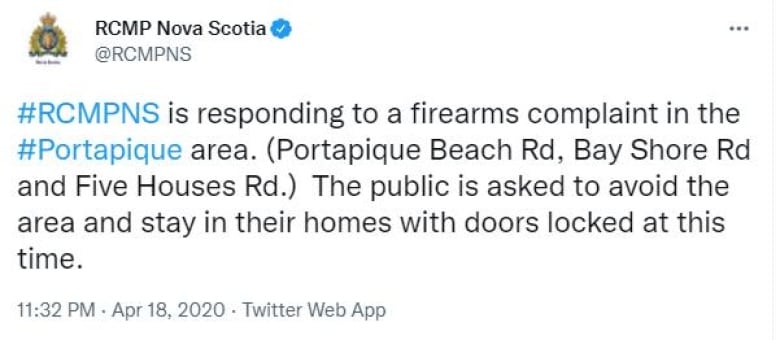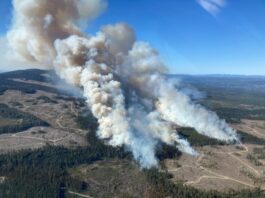
Senior RCMP members have defended controversial communication decisions during Nova Scotia’s mass shooting, including the use of Twitter instead of an emergency alert — which one manager said would have caused more deaths.
Lia Scanlan, the director of strategic communications for the RCMP during the rampage that left 22 people dead, also told investigators with the public inquiry examining the tragedy that she saw no room for improvement in the communications strategy used on April 18 and 19, 2020.
“I wouldn’t change a thing, not at all,” Scanlan told investigators in an interview last fall. “I thought about it a lot.… I wouldn’t do anything differently.”
Scanlan is scheduled to testify at the Mass Casualty Commission in Truro this week.
She told commission representatives that she had implemented the provincial RCMP’s social media policy after joining the force as a civilian employee in 2009. She said Twitter and Facebook have been effective tools for communicating directly with the public about RCMP activities.
The use of Twitter to provide critical information about the shooter on April 19, 2020, and the timing of that information, have been points of contention for families of the victims. Some have said their loved ones would not have been checking Twitter early on a Sunday morning.
The families say an emergency alert sent much earlier about the gunman’s replica police cruiser could have saved lives.
The only information RCMP had released on April 18 was that they were responding to a firearms complaint in the rural community of Portapique and that people in the area should stay inside.
The following morning, they tweeted they were still at a crime scene involving an active shooter. But they did not disclose whether anyone had been hurt or killed.

Scanlan said she used Twitter when she was deployed to Moncton, N.B., on June 5, 2014, to take over communication duties during the hunt for the man who shot and killed three Mounties and injured two more.
She said she relied on that experience when she started working on the morning of April 19, 2020.
“A lot of what we did in Codiac [N.B.] … it’s reassurance,” she said. “I remember I was like, if I was hiding in my house, because most people hide with their cellphones and most people in Nova Scotia, like we have a ton of Twitter followers, so I thought we’re there with you, like just to comfort them in some way.”
Scanlan, who told the inquiry that she’d been off-duty due to illness since January 2021, expressed frustration over public criticism of the communication tactics used during the rampage.
She criticized both the prime minister and then-premier Stephen McNeil for commenting on the lack of an emergency alert and “changing the narrative.”
“There’s no situation room, we’re not a human being attached to the police officer in the field that’s tweeting live from the field, it doesn’t work like that,” she said. “The public doesn’t know what reality is anymore in terms of communicating. This is how it’s done. There’s no other way to do it that anyone’s invented yet. I don’t know what other way you’re going to get information. Like … I can’t teleport it.”
Rural access limited
There was immediate outcry after the shootings from people who pointed out the challenges of internet access in rural Nova Scotia and that the vast majority of residents don’t use Twitter.
In response to a question from researcher Krista Smith about relying on Twitter, given concerns about accessibility, Scanlan did not directly respond. She talked instead in general terms about how the force uses Twitter and Facebook to augment more traditional communications.
“So the people in rural Nova Scotia who don’t follow Twitter and Facebook … all the news outlets follow our Twitter, so it’s kind of like Twitter and Facebook are surplus to what already existed,” she said. “It’s the best way I can put it.”
Smith and her two colleagues did not follow up.

Michael Hallowes, an expert in emergency alerts, told the Mass Casualty Commission during his testimony on May 11 that social media is not a good option for public communication during an emergency.
“The issue with social media is you have to be following, if it’s Twitter, the right channel to get the official word and it can therefore leave a lot of people out of the communication,” he told the commission.
Key information delayed
Interviews with and emails between multiple RCMP officers indicate that the force had confirmed the existence of a replica cruiser with full decals by 8 a.m. on April 19 and had distributed a photo to police agencies across Nova Scotia, including to the Emergency Response Team travelling from New Brunswick as backup.
Staff Sgt. Steve Halliday, now retired, testified before the MCC on May 17 that he had asked another senior officer, Staff Sgt. Addie MacCallum, just before 8 a.m. to work with Scanlan to send out the information about the cruiser. Halliday told the commission he didn’t know why it took so long for the tweet to materialize.
MacCallum has not testified yet but told the inquiry he sent Scanlan photos of the cruiser and then of the gunman in back-to-back emails around 8 a.m. The photo of the suspect was posted to Twitter at 8:54 a.m.

The email with the photo of the gunman was sent at 8:02 a.m. and was published by the inquiry. The email with the photo of the cruiser was not provided.
At 9:04 a.m., Scanlan emailed public affairs officer Cpl. Jennifer Clarke to ask Clarke to “pull something together” with the image of the replica cruiser. At 9:49 a.m., Clarke forwarded an email to Scanlan with the subject line “APPROVED by Steve Halliday: Tweet for approval – immediate pls.”
No record of a response from Scanlan to Clarke is provided in the documents, and a timeline of social media activity provided by the RCMP shows that it was Clarke who eventually sent out the tweet at 10:17 a.m.
Lives lost
In the time between the RCMP receiving the photo of the replica cruiser and the eventual posting of the tweet, Tom Bagley, Lillian Campbell, Heather O’Brien and Kristen Beaton were all shot and killed.
O’Brien and Beaton, co-workers at the Victorian Order of Nurses, had been texting with friends and relatives about the shootings in Portapique the night before. Beaton had received the photo of the gunman that the RCMP had tweeted an hour earlier.
In that same period of time, multiple RCMP officers told the MCC that after learning about the replica cruiser, they texted or called their own family members to tell them to stay home with the doors locked.
During the interview in September 2021, Smith asked Scanlan about the delay in posting the tweet of the replica cruiser.
Scanlan started to respond and then Smith interrupted, talking about an earlier tweet with a photo of the gunman that was posted within minutes of receiving the picture. The investigators never returned to the question of the delayed tweet.
Alert Ready ‘not a thing’
Investigators did ask Insp. Dustine Rodier, who at the time was the officer in charge of the dispatch centre, about a brief conversation regarding the use of the emergency alert system.
Staff with the provincial Emergency Management Office told MCC investigators they had reached out to RCMP to offer the use of the system on April 19 but the gunman was shot and killed as discussions about the content of the message were underway.
Rodier told the investigators the Alert Ready system was “not a thing” for the RCMP at the time of the shootings and said it would have been “catastrophic” to send one.
Her second in command, Glen Byrne, went one step further. The commander of the dispatch centre told investigators the alert ready system didn’t exist in Nova Scotia at the time of the shootings.
“It never existed in this province, no matter what anybody tells you,” he said in the interview on Aug. 26, 2021. “Amber Alert existed. Alert Ready never existed.”
The province used the Alert Ready system a week before the shootings to urge Nova Scotians not to gather for Easter, given the risk of spreading COVID-19.
Byrne said an alert issued on April 19 wouldn’t merely have been catastrophic, but deadly.
“Would it have made a difference? Yeah, it would have. More people would have died than died during that incident,” he said. “We had people on the phone that we needed to talk to who had line of sight [of the replica police car] … If an Alert Ready had been issued, we would have been answering ‘What do I do? Am I allowed out?'”
Hallowes refuted this perspective in his testimony, saying he’s never seen evidence of it happening in international jurisdictions where alerts have been used. He said public education, clear operating procedures and well-crafted alerts are essential to averting panic.
Alert policy change
The RCMP has since received direct access to the alert system and has trained officers on its use.
But Rodier told the inquiry investigators that it’s important that any future alerts come with plenty of advance warning so that communications centres can be prepared.
“It’s so important for us that if there’s even a chance that an alert is going to go out, we are going to call in another risk manager, we’re going to call in extra resources,” she said.
“We’re going to make sure all the other primary answering points in the province know this is coming because there’s an overflow in the 911 system and they’re — they’re going to feel it too, possibly. We’re going to make sure … all of the police agencies in the province know an alert is going out.”
While Scanlan, Rodier and Byrne are angry about public criticism and suggest the media are to blame for manufacturing misinformation, other RCMP members have said the force didn’t do enough to inform the public about the way events unfolded over those 13 hours..
MCC investigators asked Const. Chris Grund, one of the two officers who retrieved four children sheltering in the basement of Lisa McCully’s home, whether he felt information about the role of first responders had been properly provided to the public.
“Obviously, the victims and their families are looking for some sort of understanding of this, and … unfortunately it’s turned into some sort of — like in some followings, you know, the huge conspiracy theory stuff,” Grund replied.
“It was a horrible event, and the people that responded did the best they could. And it’s — it’s unfortunate that not sharing or not — not giving the information has really brought a distrust with the process.”
The inquiry is expected to address decisions regarding public communications this week, including testimony from Scanlan, Clarke and MacCallum.
MORE TOP STORIES












